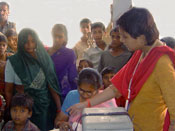Building global health leaders
August 2010 | Volume 9, Issue 4
Fogarty Scholars and Fellows can be found in rural villages and urban capitals throughout the developing world, engaged in research to prevent HIV transmission, diagnose and treat heart disease and study the causes of mental illness and other conditions. These motivated individuals are students, health scientists, medical doctors, nurses, dentists and veterinarians.
Since 2004, the Fogarty International Clinical Research Scholars Program has been offering one-year, mentored clinical research training overseas to pre-doctoral U.S. students in the health professions. In 2007, the program was expanded to include Fellows who are post-doctoral scientists already on a global health career path.
The Fulbright Program recently added its support to the initiative, joining Fogarty and its 12 NIH funding partners. Since 2007, the program has been administered through a grant to Vanderbilt University.
The U.S. Scholars are twinned with foreign scientists, native to the site country, who receive a stipend that enables them to take a full year to delve into this clinical research experience.
In all, nearly 500 young scientists have participated at 28 top-ranked research sites in 15 countries, tackling health challenges in both infectious and chronic diseases. To qualify, each location must have a proven track record of clinical research productivity and current funding from NIH and Fogarty.
The Scholars work on clinical research projects already established at the site. There are patient-oriented activities as well as epidemiologic and behavioral studies, operations research and health outcomes evaluations.
Exposure at this point in their careers is critical, says Fogarty director Dr. Roger I. Glass. “When a young person goes overseas to work in a low-resource setting, they get hooked on global health research. Their enthusiasm is contagious and it’s exciting to see leaders emerging from this program.”
Since the program’s inception, participants have published 328 articles in peer-reviewed journals and have presented research findings at numerous scientific meetings.
Another measure of its success is the growing number of alumni whose NIH applications have been funded. But perhaps the most meaningful outcome is the formation of international scientific collaborations that may deepen over time and gain significance as today’s Scholars and Fellows become tomorrow’s global health leaders.
Raabya Rossenkhan
Fogarty Scholar 2005-2006, Botswana
“My success as a researcher can be directly attributed to my Fogarty experience at the Botswana Harvard AIDS Institute Partnership and my mentors Professor Max Essex and Dr. Vlad Novitsky,” says Raabya Rossenkhan, who is in the final year of her Ph.D. work. “I benefited from their support and leadership. I’ll admit it’s probably a lot more challenging doing research in a developing country but the experience has been immensely rewarding both personally and towards my career goals.”
Rossenkhan’s Ph.D. project is a sub-study of Dr. Novitsky's acute and early infection research that is generating new information about the early phase of HIV infection as well as possible new insights to vaccine design.
After she earns her doctorate, she plans to apply for grants to conduct independent research in her native Botswana, to contribute to scientific knowledge towards vaccine design. “I would love to be able to influence HIV/AIDS policy in the developing world.”

Photo courtesy of Dr. Bloomfield
To combat the rising tide of chronic
diseases in Kenya, Dr. Gerald
Bloomfield focused on training local
health care workers in cardiology as
part of his Fogarty fellowship.
Dr. Gerald Bloomfield
Fogarty Fellow 2009-2010, Kenya
During his fellowship in Kenya, Dr. Gerald Bloomfield discovered an epidemic of diabetes, heart failure and high blood pressure among the population. Noticing a lack of expertise available to address it, he put together a series of lectures targeting medical students, residents and technicians.
“Knowing that I would never personally see everyone who needed a cardiologist, I decided to spend time teaching others so as to multiply my effectiveness. It was labor intensive and definitely a labor of love,” he says. Care improvements were his reward.
The ultimate goal of global health efforts, says Bloomfield, is to “build centers and train people to the point where we do not become independent but inter-dependent on each other.”
While in Kenya, he also made progress on his investigation of the genetic markers of atherosclerosis and the prevalence of hypertension and diabetes in certain populations.
After he completes his cardiology training next year, Bloomfield hopes to join the faculty of an academic institution where he can focus on global health issues.
By demonstrating the true burden of chronic, noncommunicable disease - through epidemiology - he hopes to influence policy changes in developing countries to stem the burgeoning tide.

Photo courtesy of Dr. Nair
As a Fogarty Scholar in her native
India, Dr. Manisha Nair explored the
high rates of coronary artery disease
in South Asians.
Dr. Manisha Nair
Fogarty Scholar 2009-2010, India
“This experience completely changed the direction of my career,” says Dr. Manisha Nair, who was focused on maternal and child health issues in her home country of India, until her Fogarty fellowship provided the opportunity to explore the high rates of coronary artery disease in the population.
The social determinants of noncommunicable diseases intrigued her, as did the challenges related to addressing them: policies, promotion and awareness. Trained at Oxford, Nair benefited from firsthand experience designing research projects during her placement in New Delhi. She was involved in designing protocols, creating questionnaires and training materials and managing the process for bioethics approvals.
“From my mentors, there was no spoon feeding,” says Nair. “It was like being thrown into a fire - but with protection so I wouldn’t burn myself. Without going through such a learning experience I would not have had the confidence and knowledge in research that I have now, to design any research project or epidemiological study.”
Nair aspires to be a policy analyst with a focus on integrating health across all public policy areas, to address the social determinants of noncommunicable diseases.
Profiles of Additional Scholars and Fellows
To view Adobe PDF files,
download current, free accessible plug-ins from Adobe's website.